 |
|
|---|
 |
|
|---|
 |
|---|
| CONTENTS |
Materials science is a prime example of a modern scientific discipline that has undergone dramatic changes in terms of breadth and depth of content within its research, industry, and education sectors. The transformation of the metallurgical field to materials science resulted from the development and increasing importance of the broad range of modern materials (including ceramics, polymers, composites, and electronic materials). This transformation and expansion has presented materials science educators with particular problems that, to a large extent, have yet to be addressed. These problems stem from courses, especially those of the introductory or service variety, becoming overcrowded with content and extremely broad in scope.2 A modern materials science textbook is around 800 pages and presents the lecturer of introductory courses with difficult decisions to make regarding which content to cover and which to omit. While judicious trimming of courses and rearrangement of content3 can partially address these problems, there are nontraditional and innovative pedagogies and educational technologies that might alleviate content overload and poor student retention by providing improved learning productivity.4 By offering the student new tools to understand concepts in action, we might provide opportunities for deeper understanding and more productive learning. These tools include animation, interactive simulations, virtual reality, and web serving to permit time- and location-independent review of course content.INTRODUCTION
"No course in science or engineering may remain static. Not only does technology advance and scientific understanding increase, the academic framework undergoes changes. Thus, periodic revisions are desirable to optimize the value of a textbook for students who will be tomorrow's engineers."—L.H. Van Vlack1
To date, the core resource of materials science courses has been the textbook. The educational value of textbooks is unquestionable, but returning to the opening quote by Van Vlack, could we better educate our future engineers by using a more dynamic medium? As Van Vlack suggests, "periodic revisions are desirable to optimize the value of a textbook for students who will be tomorrow's engineers."1 The work described in this article is motivated by the search for dynamic pedagogies and technologies that best reflect the continually evolving field of materials science.
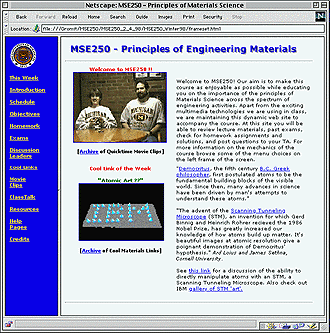 |
| Figure 1. The MSE250 website for the University of Michigan introductory materials course Principles of Engineering Materials: msewww.engin.umich.edu/mse250. |
It is important to note that we still prescribe a textbook for the course—Callister's Materials Science and Engineering: An Introduction5—however, it is the web site that fulfills our previously stated need for dynamic and current content. This content takes the form of embedded images, animations, and interactive elements as well as hyperlinks to external web sites. Embedded content is both generated on-site and drawn from previous literature, including textbooks, videos, and CD-ROMs.6,7 Where appropriate, we have sought the permission of publishers to use copyrighted materials. In an attempt to comply with the still vaguely defined copyright conventions for digital content, we have protected the actual lectures behind a password known only to our students.
Classes are taught by projecting the web site, which is browsed from a podium-mounted personal computer, through a video projector in the classroom. To avoid any network-related disasters during class, we typically mirror the lectures on the hard drive of the local classroom computer. The class is taught, and a link to the day's lecture is added to the web site so students can review the lecture at any time over the remainder of the semester. From the web server logs, which are admittedly only a crude measure of web site access, it can be seen that lectures are accessed remotely an average of 200 times per semester (this equates to about one after-lecture access per student per lecture). This figure is an indication of how many times a particular resource was loaded; unfortunately, it gives little information about how that resource was used, who used it, and where they browsed to next. These data would be very useful to educators, but the tools to conduct this sort of student tracking through web-based multimedia are only just becoming available.8
There is currently nothing but course ratings and anecdotal evidence to judge the success of the web-based approach, but these course ratings showed a 100-150 percent improvement after the introduction of the web-based format. These ratings are drawn directly from a student poll at the end of term and are based on their responses to questions on the quality of the course and lecturer and the amount of knowledge learned in the course.
We have decided not to conduct detailed pedagogical studies on the effectiveness of the web-enhanced teaching approach for several reasons. Numerous studies have shown that there is no significant difference in the effectiveness of multimedia-driven versus traditional classroom teaching techniques.9 Further, we subscribe to the view that there are various preferred learning styles inherent in students;10 that is, all students have a preferred learning mode (e.g. visual, reflective, or experiential). The combination of web site, lectures, and textbook allow us to address a diverse population of these learning styles. Finally, we have adopted the learning objectives approach of Stice11 to precisely define the required level of understanding that we expect of students on a specific set of learning objectives on topics covered in the course. This approach is appropriate to all courses, but is particularly effective in courses that are as broad in conceptual coverage as typical introductory materials science courses.
The course has been taught in this manner for four consecutive semesters, with four different faculty taking the helm. The core resource, the MSE250 web site, has evolved with each lecturer's additions. It was found that the web site has forced a consistency in teaching and allowed integrative improvement with each passing semester. We feel that the web is the perfect medium for the generation of a so-called dynamic textbook.
Regardless of the sometimes uncertain evolution of HTML, it remains an effective technology for producing educational content, with some specific advantages:
HTML was never designed to directly compete with traditional multimedia authoring tools such as Authorware and Toolbox, but the combination of HTML and closely allied technologies such as QuickTime, Javascript, and Java allows the production of significantly interactive web pages.
The process of designing and maintaining larger web sites is not trivial and may require the educator to learn some new skills.13 An alternative to manually maintaining course web sites is to use one of the many web course tools designed and specifically marketed to aid educators in maintaining web sites to support courses. Examples of such tools include WebCT, CourseInfo, and Asymetrix Librarian. These tools allow many of the typical aspects of maintaining a course web site to be accomplished without any actual HTML coding, typically via a web-based interface. These tools are worth investigating although they typically sacrifice flexibility for ease of use.
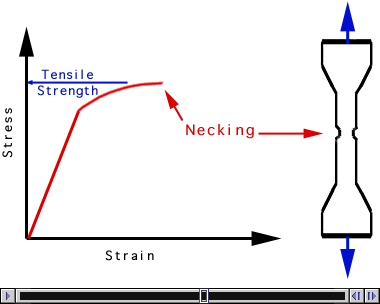 |
For delivering materials-science-related content, we have found QuickTime to be perfect for animations that can be stepped through one frame at a time, such as the animation shown in Figure 2, which shows the evolution of a stress-strain curve and how this relates to a standard tensile test.
It is also suited to longer video clips that are designed for continuous play, such as the video shown in Figure 3, which shows how a tray of marbles can be a useful analogy for illustrating concepts such as crystallinity and defects such as grain boundaries and vacancies. Finally, QuickTimeVR can store and render pseudo-three-dimensional (3-D) environments, but we have not yet found an educational use for this capability.
QuickTime is a file format that is not natively supported by browsers such as Communicator or Internet Explorer. A QuickTime plug-in must be downloaded specific to the operating system and platform being using. Plug-ins are software components that literally plug into the browser to handle specific types of embedded content within web pages; Java presents an alternative to plug-ins and is more attractive in many respects.
Some newer technologies have appeared recently that bear mentioning due to their highly web-specific capabilities. Macromedia Flash is a combination of a two-dimensional (2-D) animation production suite, file format, and a browser plug-in. The file format is extremely bandwidth-optimized, a complicated way of saying that the resulting animation files are extremely small. This and the fact that the animation production software is quite easy to use, makes Flash a good choice for 2-D animation development and delivery. It can also export QuickTime movies (Figure 4), which means that people who prefer the versatility of QuickTime can still use Flash's well-developed 2-D animation production tools. Flash has been submitted by Macromedia to the standards bodies governing the Internet as an open standard for vector-based animation.
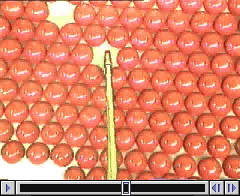 |
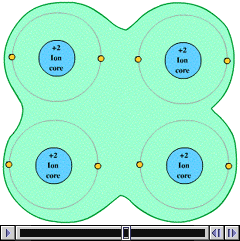 |
RealNetworks has produced a line of products specifically optimized for the streaming of multimedia content, including sounds, movies, and animations, over the Internet. Streaming refers to the capability to simultaneously download and view content before the content is completely downloaded. This technology has a number of components: publication tools to convert content into streamable content, server-side tools to dynamically stream content, and a plug-in to play the content while it streams into the browser. In many ways, this technology directly competes with and improves upon Apple's QuickTime format, but does not yet have the same wide industry acceptance. However, educators are using RealNetworks technologies for applications such as distance learning via the World Wide Web.14
Producing animations and video clips is a time- and effort-consuming process, but it is often rewarded with tools for explaining particular concepts that would be difficult to explain using simple static text and imagery. This had led us to believe that other educators might be interested in accessing, using, and even modifying our animations. Therefore, we are currently developing a web-based repository of animations and other so-called learning objects that will allow materials science educators to search for animations addressing particular concepts or processes.
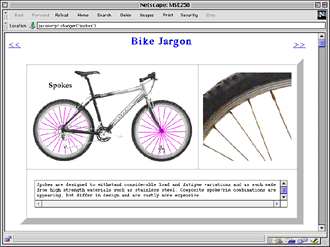 |
Javascript is the simpler scripting language dedicated to handling interaction with various objects within web pages, such as browser windows, frames, images, and forms. However, it can be used to accomplish a considerable degree of interactivity, as demonstrated in the small demonstration page that comprises Figure 5; it is part of a lecture on the materials issues associated with the bicycle. The language itself is not designed to be a complete programming language, but can be interfaced with higher level technologies such as Java and virtual reality modeling language (VRML). Learning Javascript is a good precursor to learning Java, as the two share similar syntax and data structures. Visual Javascript is available for those not wanting to hack code.
Java is based on principles that are particularly suited to the development of educational software for web-based delivery. These aspects include:
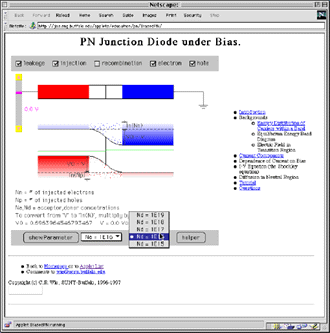 |
| Figure 6. A Java-driven web page at the State University of New York at Buffalo that shows a simulation of biased PN junction.11 (Click on the image to visit the site.) |
As reported in a recent article,15 the current landscape of educational computing is constrained from more meaningful growth by the fragmentation of authoring tools such as HyperCard, Director, Authorware, and Toolbox and other proprietary standards. Roschelle et al. postulate that educational computing would become productive and meaningful if code fragments could indeed be combined to form new functionality.15 There are many educational applications and simulations that require similar components—for example, graphing, plotting, animating, and rendering functionality are all common functionalities, so why recode this functionality every time it is needed? Java is specifically modeled with this functionality in mind. The producers of the aforementioned authoring tools are gradually supporting Java, but it remains to be seen if they appreciate the full possibilities for reusable software components for education. One educational effort that appreciates the future of reusable educational software components (particularly written in Java) is Apple's Educational Object Economy.
The work of Wie et al. is a prime example of the educational power of Java.16 Wie et al. have developed a series of applets illustrating many aspects of semiconductor device manufacturing and operation. These applets are powerful in that they go beyond simple animation and allow users (educators or students) to change operating and starting conditions within the simulations. A great example of this functionality is the biased PN-junction simulation that allows users to change the bias and the density of charge carrier and see the effect of various aspects of current flow through this device (Figure 6). Concepts such as recombination, electron and hole flow, and leakage can be explain verbally or with static imagery, but the understanding of these concepts must surely be improved if the device can be simulated, allowing user experimentation and learning by doing. The opportunities from both teacher and student points of view are considerable; teachers have new tools and dynamic methods to demonstrate concepts in action, while students gain access to pathways to understanding that were previously unavailable to them through experimentation.
|
The ChemSymphony web site offers several download options, ordering information, and help pages. |
Software has long been available to do this sort of thing, but what is new about ChemSymphony is that this Java applet can easily be incorporated into web pages and will run perfectly on any platform that supports Java. The same company also licenses a second version of ChemSymphony that is essentially a set of building blocks for the development of chemistry tools, which can be plugged into each other and with third-party objects. These objects are based on the JavaBeans specification that is widely supported by the many makers of visual Java development tools.
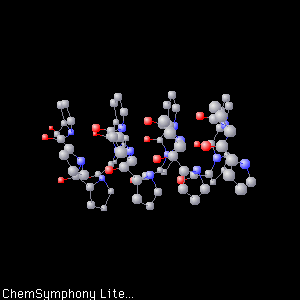 |
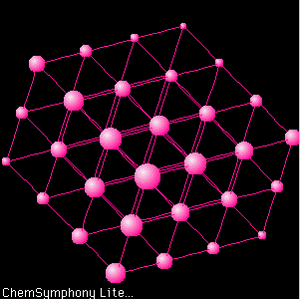 |
| a | b |
These developments must surely be an encouraging sign that some of the problems with educational multimedia can be overcome. Platform-specific software is not compatible with the general goals of the wider educational community. Hopefully, as efforts such as the Educational Object Economy continue to archive the efforts of educational Java developers, innovative educational software might become more widely available and at the same time be easier to develop and implement.
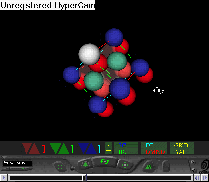 |
| a |
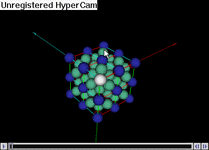 |
| b |
An area of materials science that is traditionally conceptually difficult is crystallography. Attempts to simplify things to two dimensions usually fail because almost all actual crystal structures are 3-D. A good understanding of the subject is essential to understanding how the microstructure of materials relates directly to their macroscopic properties. To consider a constructivist or learn-by-doing approach necessitates a medium in which it is possible to interact with atoms, construct and manipulate crystals in real time, and view the resulting structures from any angle. Ideally, crystal structures could be built, examined, and manipulated in a virtual reality environment.
Crystal Explorer is an interactive 3-D crystal viewer that attempts to overcome some of the hurdles of introductory crystallography by providing users the opportunity to interact with a virtual set of four crystal structures: simple cubic, body-centered cubic, face-centered cubic, and diamond (Figure 8). The ability to add planes of specific Miller indices combined with VRML's ability to navigate through all possible viewpoints gives the user an extremely powerful tool to visualize crystal structures.
VRML is not an easy language to work with, but it does provide a platform-independent means of handling significant levels of interactivity. Its main competition within the educational arena lies with specialized 3-D viewers, such as ChemSymphony, which are less general, but are individually better at their specific rendering tasks.
These technologies have been successfully utilized within our introductory materials science courses to bring laboratory experiences into the classroom. For example, during a case study on the materials issues of a hip replacement joint, we examined a failed joint in a remote scanning electron microscope live from the 300 seat auditorium. We were able to show the fatigue fracture surface and the likely cause of the failure—a misplaced manufacturers logo. This approach both reinforces the fundamentals of failure that were covered earlier in the term, but also introduces, even if in a remote manner, important research techniques such as microscopy and failure analysis. The educational possibilities of the remote control of laboratory equipment are extensive and obviously practical in cases where there is no other way to include laboratory or hands-on work within a course.
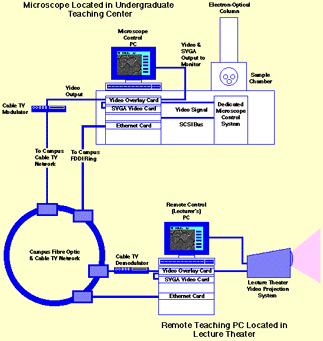 |
| Figure 9. A schematic showing the implementation of hybrid cable television/Internet remote-control SEM.12 |
While individual curricula and teaching approaches may vary slightly, the subject matter within courses and degrees within disciplines is largely similar at many institutions. At the moment, conferences, educational workshops, and journal articles18 are the only way to keep abreast of the latest developments. As a result, the chances of duplication in effort are extremely high. Individually, educational developers may also be geared toward particular approaches to media development and be better equipped to produce certain media types, such as video, 3-D animation or imagery, or, at another level, case studies or experimental procedures.19 A shared approach may lead to better utilization of the broad range of developmental resources and capabilities that already exist.
Ideally, educational multimedia is flexible to individual lecturers' approaches and not set into a particular format or presentation order. This might suggest a development model based on modules at one scale and individual media objects at a still finer scale that could be customized and incorporated into particular courses by educators. A more obvious goal is to maintain a high degree of developed content quality. This is one goal that is well met by an open development model, in that it inherently allows for peer review and widespread usage, review, and optimization.
By no means is the Internet the solution to all problems associated with educational development, but it is definitely an ideal way to accommodate a shared developmental model for educational resources. By adopting a code/object/media sharing model, development costs could theoretically be reduced; simultaneously, more people could be involved in the development and utilization of educational multimedia. This would be accomplished technically by web-based repositories cataloging all available media objects, offering participants the ability to download, modify, upload, and review multimedia objects. The use of the Internet, therefore, provides the development, delivery, and peer review mechanisms.
Web-based technologies have emerged that are perfectly suited to a shared development model, based on object/code reuse and continued development. Most of the technologies discussed earlier fit perfectly into the shared development model and with the goals of object sharing, reuse, and continuous improvement.
Another technical issue to be addressed is the development of multimedia databases or repositories to provide cataloging and search and retrieval functions, as well as the mechanism for peer review to ensure quality. Such a repository is the Materials Education Library, which is currently in an early evolutionary stage. It is based on a template provided by a consortium led by Apple for the setting up of educational object economies. The template has been customized to suit the particular needs of the community and is based upon many of the ideas discussed here, particularly the idea of reducing development to the level of individual objects that can be incorporated into larger customized modules. At the time of writing, the site offers:
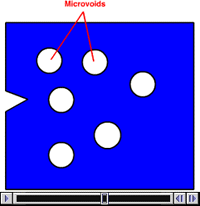 |
| Figure 10. An animation of crack-tip blunting submitted to the Materials Education Library |
The goal is to catalog a wide variety of objects from a wide variety of contributors and to eventually contain not only individual multimedia objects, but more integrated materials-related modules, such as case studies and in-class demonstrations. The resource is very flexible and can be customized to suit future needs as they arise.
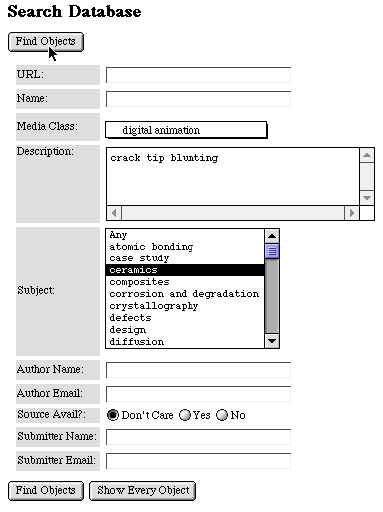
| 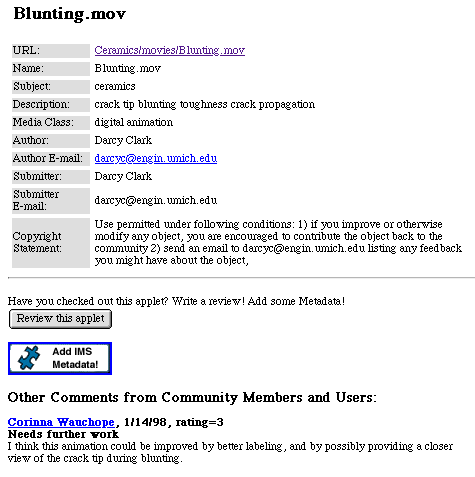
|
| Figure 11. The search interface at the Materials Education Library showing how multiple criteria can be combined to find particular objects. | Figure 12. The peer-review mechanism at the Materials Education Library for users to contribute feedback (in this case, on the animation shown in Figure 10). |
There are some important problems with the concept of a shared model, of which the following are a subset. The question of copyright and ownership of content is important, as is whether or not this model of development necessarily excludes commercial development. In light of a shared development and usage model, copyright certainly could have a different meaning; in fact, some people are even considering whether copyright law as it stands is serviceable in the electronic age. Others have the opinion that existing copyright law could be modified to account for electronic publishing. What form copyright will take and what privileges it affords to the originators and end-users of intellectual property are still open questions.
The precedent for free distribution of intellectual property exists in the world of operating systems. Linux is a true community-based effort, where time and effort have been contributed solely because the participants feel that their contribution to the resource is rewarded with a useful operating system. Could this philosophy be transferred to the development of teaching resources? It is the author's opinion that education is a wholly appropriate field for development under this philosophy. An originator of an object could claim copyright on that object, but release it for download, usage, and even modification—provided that if the object was improved it had to be contributed back to the community. This encourages utilization (who can resist something for nothing?), but also includes mechanisms for modification and, by implication, cooperative development.
Regardless of free-distribution models, there are economic alternatives to be considered. We might look to the software industry for some pointers. It is becoming increasingly common for software to be marketed in component form, where smaller blocks of code that perform specific tasks can be purchased or licensed in order to save time and development effort that would be needlessly replicated. This model would seem to spring from the increasingly object-oriented nature of programming.20 Companies are also developing real technologies that accomplish the electronic exchange of intellectual property21,22 that also allow for economic recompense to the originator of that property. We might, therefore, predict that practical means of sharing intellectual property that do not necessarily exclude ownership and copyright will soon become available, and these technologies might be applied to the exchange of educational content.
At the University of Michigan, we have successfully integrated web-based multimedia into an introductory materials science course for four consecutive terms. The web appears to be well suited to the interactive development and improvement of resources associated with a particular course. At our institution, it also appears to have enforced a consistency of approach from semester to semester, even when lecturers have changed. At the same time, each lecturer has been able to adapt the same resources to fit their particular approaches to teaching.
The web seems to be the logical medium through which we might develop a national and even international learning infrastructure for our specific discipline. Multimedia technologies are available or are currently being defined that are free from the typical constraints of proprietary technologies that have dominated the multimedia landscape in the past. Within our community, we have the opportunity to work together to maintain at the very least a resource that enables us to share media objects, ideas, and information relating to educational programs. The mechanisms to accomplish this (e.g., the Internet and the Materials Education Library) exist and are yet to be utilized to their full capacity.
The author thanks several important collaborators for their input into the work described above. Professors Steven Yalisove, David Srolovitz, Rachel Goldman, and Dr. George Wynarsky have all taught the course in its web-based incarnation and have been instrumental in curriculum development. Professor Yalisove in particular has been integral to both the initial and continuing developmental efforts. Dr. John Mansfield of Electron Microbeam Analysis Laboratory was responsible for the pioneering work done on remote instrumentation of scanning electron microscopy instruments. The author also thanks Jason Johnson for his work on the Crystal Explorer described in the VRML section of this paper, Antonio Roque for developing the interactive Javascript demonstrated in the Java/Javascript section, and Jacquelene Steele for developing the QuickTime animation shown in the animation and video formats section.
ABOUT THE AUTHOR
Darcy J.M. Clark earned his Ph.D. in materials science at the University of Queensland in 1996. He is currently a visiting assistant research scientist in the Department of Materials Science and Engineering at the University of Michigan.
For more information, contact D.J.M. Clark, Department of Materials Science and Engineering, University of Michigan, Ann Arbor, Michigan 48109-2136; e-mail darcyc@engin.umich.edu.
Direct questions about this or any other JOM page to jom@tms.org.
| Search | TMS Document Center | Subscriptions | Other Hypertext Articles | JOM | TMS OnLine |
|---|